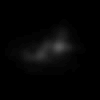

Multiple stellar images were taken during planetary imaging runs to show the seeing. While the seeing generally changes a bit during the night, these are representative. These movies were usually taken just after focusing the telescope for a nearby planet, so they did not detract from the main objective. Some of the time, diffraction rings in the Airy pattern can be seen, especially in single frames where the contrast is turned up. The average motion of the star has been removed by post-processing, since most of the motion was due to telescope drift and periodic error, not atmospheric motion. Image stabilization was not used in these movies, since the star was usually too dim and the exposures were fairly short.
Stellar image motion April 8, 2003
Click on the frame above to see the stellar motion taken just after the Jupiter image the same evening. Seeing was just above average. A total of 85 consecutive frames were added to make the movie here, each frame a 0.2 second exposure of Regulus taken through a green filter. Some frames are nearly diffraction limited, but most have a wave or so of image aberration. The actual frame rate was about 16 frames/minute. No image processing was performed on the images, but each frame was quadrupled in size to make the viewing a little easier.

This movie is composed of 42 frames, each image a 0.5 second exposure of a star through a green filter. The bright center is the core of the Airy disk. Some frames show the first diffraction ring, but since it is so dim, its difficult to see unless atmospheric turbulence just happens to cause the ring to become temporarily brighter. A 10 second image of Saturn and a four second image of Jupiter taken before and after these movie frames are posted in the Jupiter and Saturn pages linked to the Image Gallery page. Since those exposures are equivalent to 8 or 20 frames in the movie, it shows how difficult it is to get diffraction-limited images in this type of seeing. Unfortunately, this is considered "good" seeing in San Diego for much of the year, but some days in the summer can be much better. Those movies will be posted when available! Very short exposures might help in some cases, but then the noise is usually pretty bad. Combining many short exposure images is another cure, but each exposure must be long enough to get the signal high enough so that the combining process is possible. Getting good images means taking a lot of them, and planet rotation is a problem except for Saturn. These are the tradeoffs inherent in high-resolution planetary imaging, and highlights the benefits of the AO-2 image stabilizing system.
Return to the Image Gallery index page
Return to Stellar Products home page